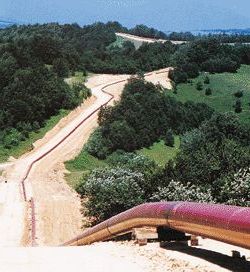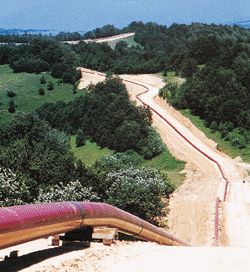


 Growth in the worldwide demand for natural gas is outpacing the demand for any other hydrocarbon fuel.
Growth in the worldwide demand for natural gas is outpacing the demand for any other hydrocarbon fuel.
-
"Reserves for the Caspian Sea region [are] speculatively quoted as 200 bln barrels of oil and over 600 tcf of gas.
The Southern Caspian alone is equivalent to one or even two North Seas"-
Development of Caspian Sea oil and natural gas, along with the necessary export pipelines, has been slowed by regional conflicts, political instability, and a lack of regional cooperation. Many of the proposed export routes pass through areas where conflicts remain unresolved. Although new oil and natural gas export pipelines offer the hope of longer-term prosperity, the region's numerous flashpoints and ongoing instability have caused energy companies and potential investors to think twice before investing in the construction of proposed pipelines.
Most of these conflicts are in the Trans-Caucasus part of the Caspian region, where conflicts in Nagorno-Karabakh, Georgia, and the Chechen republic of southern Russia have hindered the development of export routes westward from the Caspian Sea. On the east side of the Caspian, the unstable situation in Afghanistan, following over 23 years of war, has stifled the development of export routes to the southeast, and the continued threat of Islamic fundamentalism in Central Asia, especially in Uzbekistan, may prohibit any new export pipelines involving that country. The threat of war between Pakistan and India serves as a further deterrent to Caspian export pipelines running southeast, either via Iran or Afghanistan.
NATURAL GAS
The Caspian Sea region's natural gas potential is, by some measures, more significant than its oil potential. Regional proven natural gas reserves are estimated at 232 trillion cubic feet (Tcf), comparable to those in Saudi Arabia. Natural gas production in 2001 was approximately 4.5 Tcf, comparable to the combined production of South America, Central America, and Mexico. But companies and governments have thus far shown greater interest in oil than in natural gas--owing, in part, to the greater capital expenditures necessary to start up new natural gas projects, as well as the region's lack of existing infrastructure. As a result, regional natural gas production has increased only modestly since independence. With only one major foreign investment focused primarily on gas (Azerbaijan's Shah Deniz --see Table 1 and below), the region will still need considerable investment in upstream projects and export infrastructure before its full potential can be realized.
Geopolitical maneuvering between Russia and the United States is intensifying in Central Asia, with Kazakhstan serving as main arena of competition. In recent years, Kazakhstan has pursued a "multi-vectored" policy that attempts to balance the interests of Russia, the United States and China. But recent developments suggest Astana is starting to tilt in Moscow�s direction.
The primary catalyst for closer Kazakhstani-Russian ties was Russian President Vladimir Putin�s January visit to Kazakhstan. Since then, Kazakhstani and Russian officials have probed stronger ties in a variety of economic, strategic and even political areas.
In September 1994, for example, a British Petroleum-led consortium signed an $8 billion agreement to develop Azerbaijani oil fields.
The challenge for Moscow is to try to preserve as much control as possible over the transportation of these resources. After all, if the West can build a southern Caucasus oil corridor through Azerbaijan, Armenia, and Georgia, Russia will lose transit fees amounting to billions of dollars that will be used by southern Caucasus countries to strengthen their independence. Faced with this danger, Moscow has responded by attempting to divide and conquer. After losing the key republics of Georgia, Armenia, and Azerbaijan in the early 1990s, Boris Yeltsin exploited three separatist movements in South Ossetia (Georgia), Abkhazia (Armenia), and Nagorno-Karabakh (Azerbaijan) in 1992, while repressing the three restless minorities of North Ossetia, Ingushetia, Chechnya, and Dagestan, located in the northern Caucasus within Russia�s borders. Today, none of the southern Caucasus conflicts have been resolved, including the war in Chechnya, a situation that Moscow is exploiting in order to justify Russia�s military presence there.
Alice-Catherine Carls/Public Justice Report 3rd Quarter, 2000
______________________________________
______________________________________
Some 30-180 billion barrels of oil and 7.9 trillion cubic meters of natural gas are estimated to rest in the Caspian basin � virtually all of it in Kazakhstan, Turkmenistan, and Azerbaijan. Thus, though the region seethes with political unrest, ethnic conflict, and a dozen violent secessionist rebellions � some of which could spread far beyond their national borders � the Caspian also offers significant strategic and economic advantages to any state that could come to control it.
Caspian Sea Oil
Woodrow Wilson School, Princeton

